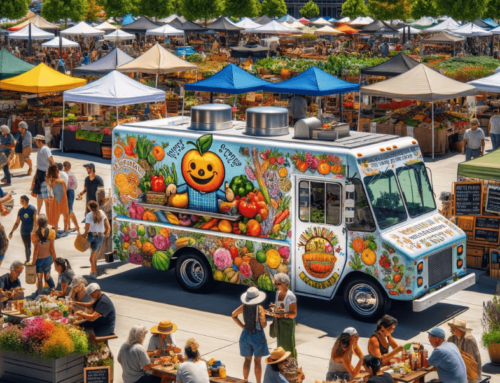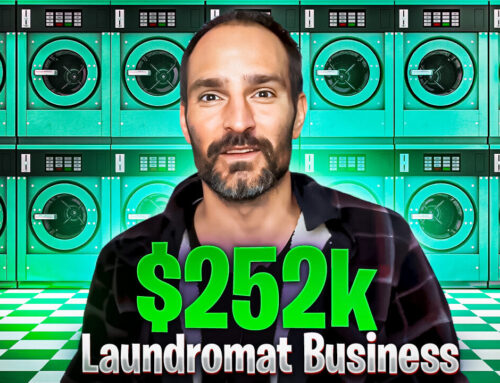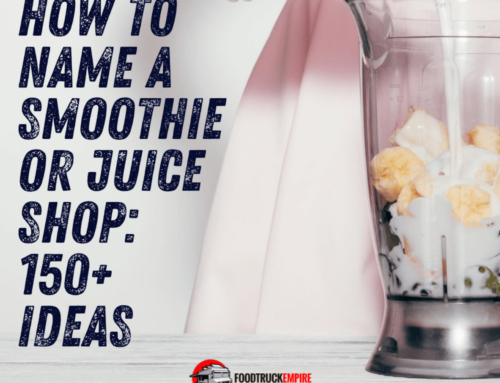Want a simple way to brainstorm a food business idea? Creating a one-page business model canvas is a great way to get your concept onto paper without spending weeks or even months writing a detailed business plan and then deciding if you should move forward.
Seriously… there is a better way!
More often than not, you can invest half an hour filling out a business model canvas template to document what you plan to sell, how you plan to sell it, and even the ideal prospect you’d like to sell to. You’ll get a rough estimate how much capital the business will need to start and initial revenue projections.
Best of all you can use this template to analyze any type of food business: a restaurant, retail food product / beverage, coffee shop, and of course a food truck.
If the business idea passes this initial test, you can move onto writing a business plan that will include more detail analysis about the operations and financial considerations for the business.
In this piece, I’ve included a free business canvas template you can download for free and provided training on how to complete it for a food business using examples from my own popcorn company.
Ready to start building a real plan for your startup? I hope you’re as pumped as I am to get your business going. Read on.
Background: What is the Business Model Canvas?
For the record, I didn’t invent the business model canvas. The Swiss business theorist Alexander Osterwalder is credited with that accomplishment. This model is used frequently by the tech startup community, but not well known in the food business community. I did adapt and simplify the canvas to be more relevant to a restauranteurs or whatever food venture you’ve got planned.
The standard business model canvas has nine core elements. This food business canvas only has seven elements because I think you can group some of them together for food businesses. No need to overcomplicate what can be made simpler.

Download this template below.
Here are the key benefits to completing a business model canvas in my opinion:
- Speed: A business plan can take weeks or months to put together. Ain’t no one got time for that! This gives you a quick back-of-the-napkin idea of our a business will operate.
- Weed out bad ideas: You could legit brainstorm a half dozen business models in an afternoon if you aren’t sure what direction to take your business. If the business doesn’t make sense scrap the idea and move onto something else.
- Explain Idea to Others: This one-page document can be used to explain your business ideas to others including family or potential angel investors. The best businesses are usually the ones that can be simply explained and understood.
Example of food business model canvas + template download
- Blank Business Model Canvas in PDF: Print a few copies to set the foundation of your business.
- Blank Business Model Canvas in Word Doc: Save a tree and complete this on your computer.
- Restaurant Business Model Canvas Example in Word Doc: Perfect if you’re planning to open a restaurant.
- Popcorn Business Model Canvas Example: Here’s the canvas I completed for my business.
Here’s another resource of business model canvas templates. These aren’t specific to food businesses, but it’s a good source of additional information on the topic if you’re looking for another example.
Now that you’ve got your template in hand, it’s time to put ink to paper so to speak. The foundation of your future business officially begins in our next step.
Mission Statement
Going back a few years, I was not big believer in mission statements. They didn’t seem practical. I felt like they written to make the founder of the company sound smart or a meaningless task I had to complete for school. But I’ve completely changed my mind.
After interviewing 100+ successful business owners on the podcast, I realize food entrepreneurs with the biggest successes are those that take their mission statement seriously. When used in the right way, a mission statement actually guides every major decision in a business. In fact, that’s what grinding principles like this are supposed to do.
Here’s my current mission statement as an example:
Our mission is to provide the highest quality, small-batch popcorn with creative flavors. We continually think of ways to create consistent, memorable, and fun customer interactions. Our mission also includes being a good member of the community by donating to and helping fundraising efforts of deserving local organizations or people.
Reader Note: I will no doubt adapt and tweak this in the future although the core mission will stay the same.
This mission statement is okay. I will improve it with time.
But here’s the thing. Understanding how each sentence directly impacts the actions of my business is what’s really important. After all, actions are the most important part. If you don’t plan on using the mission statement to help guide the direction of the business, you might as well not write one at all.
First, my goal is to deliver a great product (in my case bags of popcorn) for customers. Another goal is to offer creative flavors. This means that I won’t be selling bags of kettle corn exclusively.
Instead, we’ll rotate more innovative flavors like pumpkin spice, caramel apple, or Chicago mix popcorns. Coming up with new flavors is part of our mission so it’s absolutely something I have to follow through with. Otherwise we fail to live up to the mission statement I created. And that sucks.
You probably have a different vision for your own product. Maybe you want to cater to make exceptional tofu burgers for the growing vegetarian community. Perhaps serving responsibly raised, non-GMO or 100% organic pork from your BBQ trailer is the foundational. If so, include these critical details in mission statement section.
Related Reading: The 6-Step Marketing Growth Plan for a Home-Based Bakery
In sentence number two, I proclaim my customers deserve a consistent, memorable and fun experience with us that they won’t find anywhere else. Of course, everyone says that. The thing that makes me different is I actually have a specific plan for delivering on these claims.
Some ways I ensure a unique customer experience is through the design of the trailer. You can actually watch the popcorn being made inside the trailer. You can also watch the process of the popcorn being seasoned, bagged, and handed out the window to you. As a customer, you know our popcorn is as fresh as it can be. You watched the sausage get made form start to finish.
It’s a little thing. But it’s memorable and sets us apart.
I see other kettle corn vendors make their popcorn in advance, bag it, and then wait for customers to come along and buy it. Rookie mistake.
From a business standpoint, I totally get it. If you make a bunch of bags of popcorn in advance, you can sell it faster. The problem is I can get a pre-popped bag of popcorn at any grocery store or gas station.
Getting a fresh popped bag that you watched being made makes us different. Part of the unique value of buying a bag of popcorn from us is that you get to watch a little show! Your popcorn being made!
The third sentence in my mission statement is self explanatory and something a lot of other businesses do. I want my little popcorn business to make the community a better place even if it’s in a small way.
There are plenty of worthwhile organizations in need of funds in my area: kids sport teams that need jerseys, families trying to pay the hospital bill for a sick kid. It motivates me to be on my game when I know that there’s a greater cause to the business. I also believe this approach helps my business overall even though I might not make as much directly at any given event.
By the way, if you need more help on this subject, check out this lesson on starting a coffee shop. This process of identifying your mission statement and guiding principles applies to any business.
Products / Menu
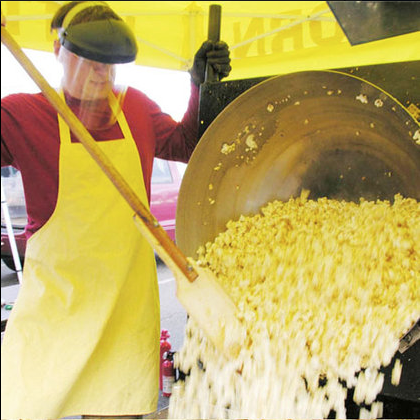
So much kettle corn!
The nice thing about launching a food or beverage business is that the product is straight forward. You make edible item(s) and sell it to the public. No exhausting explanation required here.
If you plan to open a restaurant, you’ll want to list the signature dishes here. You won’t have enough space to document each specific ingredient needed to make a menu item (that level of detail is more appropriate for the business plan). If you plan to serve wings, outline your top flavors like Buffalo, BBQ, and Asian Zing. Create outline your core menu items so that people understand the specialty.
I also like the idea of giving a ballpark price for the menu item. You can get a sense of what the market is willing to bear from a price perspective quickly by seeing what other comparable restaurants or food vendors are charging in your area.
If you are planning to sell a packaged good like artisan pickles in a jar, check your local grocer for an average retail price or search for something similar online. Again, you’ll do more in-depth analysis at a later time. This is a gut check to see if the idea has merit and decide whether or not to move forward.
As an example, here’s what I have listed in the products / menu category for my own business:
- Large Bag of Popcorn (One size only)- $10
- Rotating Flavors:
- Traditional kettle corn
- Pumpkin Spice (Fall – Seasonal)
- Parmesan Rosemary
- Garlic Herb
- Everything Bagel
- Salt & Vinegar
- Rotating Flavors:
I likely have a simpler offering than you may envision, especially if you operate a restaurant. That’s fine. Although I will say that having a focus is a great way to stand out. Many food and beverage brands start with only a handful of products or flavors to keep things simple in the beginning and add more when the business grows.
Value Proposition
Say your plan is to open a taco shop. That’s great! I think this is a proven business model that can work well in literally any market in the United States. The challenge is differentiating your taco shop from the what could be dozens of other shops in a five-mile radius if you live in Southern California like I do.
The value proposition of the food business canvas is supposed to answer this question. What makes your food product different than other similar products based on the competition on your market?
Here are a few time tested ways to create a unique value proposition with food or beverages:
Sell something that you can’t find anywhere else is always a good approach. One example of a previous guest we featured on our blog started a switchel beverage company. I never heard of switchel before the interview, but it was evidently a popular drink in the 17th century. Who knew! If you can come up with a little known food or drink like this then you’ve got a built-in value proposition.
To boot the drink boasts health benefits that include easing an upset stomach and can be used as a key ingredient in cocktails.
Here are a few proven ways to differentiate a food product:
- Is there a new or unique spin you put on the food? Asian fusion tacos come to mind.
- Do you incorporate any unique ingredients? Is it organic? Made by hand? Small batch?
- Do you have any unique process for making the food that makes it better?
- Is the food or beverage difficult to find in your area? It’s not easy to find quality Cuban food where I live.
- Are there any legitimate health benefits you can feature? Even kids breakfast cereals are touting their products are high in whole grains.
- Are you delivering this food in a new way? 10-years ago food trucks were really exciting and innovative way to eat lunch. Not as much anymore.
- Does your product address a certain segments pain point?
- Can you offer a unique experience to guests? One restaurant that comes to mind is Dick’s Last Resort where the wait staff is mean to you. That’s certainly memorable!
- While you don’t want to resort to gimmicks, sometimes having something like an ongoing hot-wing eating contest similar to Buffalo Wild Wings can garner some free press.
Sales Channels

Plating BBQ at the restaurant.
In this section, you will outline the sales channels you plan to sell your food. For food businesses this will be a straight forward activity, but it’s worth getting clarity on so you can begin to build a marketing plan that makes sense for that particular channel.
Here is a list of the most popular sales channels for food businesses and a short description of each option:
- Brick and Mortar: Restaurants, bakeries, and coffee shops fit into this category. Customers drive or walk to you to get food.
- Drive Thru: A QSR industry report claims 70% of all quick serve restaurant orders go through a window. Having a drive thru impact operations so including this distinction in the plan is essential.
- Delivery: Unless you want to rely on Uber Eats, you’ll need to hire drivers and establish guidelines for delivery.
- Catering: Catering corporate lunches or weddings is a lucrative channel that’s desired by restaurants, food trucks, and full-time caterers alike. Learn more about starting a home-based catering business here.
- Mobile events (like a food truck, trailer or cart): If you plan on operating a truck or trailer you’ll want to add events to the business canvas.
- E-Commerce Website: If you sell packaged goods like mustard, hot sauce, pickles, or even fully prepared meals, a website will likely be one of your top sales channels.
- Amazon: Similar to having your own website, you can also sell qualifying food products on Amazon. This website has an enormous base of customers so it can really bolster sales if you’re on the platform.
- Retail sales like grocery stores or convenience stores: If you have your sites set on entering the prepackaged retail space, you’ll want to have a sales and marketing strategy in place here.
Another way to think about sales channels is to ask yourself, “Where are people going to be paying for my small-batch hot sauce?” This could be online, at a fair, or near the cash register of your restaurant.
Customer Segments
In this section you will define the type of people that will want your product. Once you understand who will be purchasing your product, you can start the process of working backwards to figure out how to get in a place where your people work or play.
If you operate a healthy juice brand that wants to target men and women that work out 5k’s, weight lifting competitions, or a location near a busy gym could work well. These places naturally attract health-focused people that drink smoothies regularly.
Related Reading: How I Opened a Restaurant with No Money and a 540 Credit Score
Don’t just identify the individuals that buy your product directly to include in the customer segment section, however. One of my segments is managers of local wineries near my home. I live in Southern California within 10 miles of roughly 40 wineries. Many of these wineries have regular food truck friendly events. Building relationships with these managers is important to my business because so I list this unique segment in the plan as well.
Another way to this about this section is to define the key relationships do you need to establish in order to grow the business. If my focus was on securing wedding catering, I would add local wedding planners and popular venues to my list.
Business Expenses

Thinking about expenses…
Some food business models can be bootstrapped with limited. A hot dog stand or coffee bike both come to mind when it comes starting a business on a budget. Other models like starting a restaurant or large coffee shop can quickly approach the 7-figure range. In this section, we get some back-of-the-napkin estimates of how much your idea is going to cost to get off the the ground.
You should break these anticipated business expenses into two separate categories. First are the expenses associated with starting your business. You will incur the highest costs in the beginning of the business. Then you need to come up with the monthly costs required to stay in business.
Common Startup Expenses:
- Cooking equipment
- Vehicles, trailers, truck
- Restaurant lease, design and construction
- Permits / licenses
- Website design
- Initial Inventory
- Staff
Common Ongoing Expenses:
- Rent
- Insurance
- Inventory
- Loan payments
- Gas (if mobile)
- Staff
- Phone / internet
- Taxes
If you want a more detailed look at a startup cost analysis for a food truck, check out this blog post.
The other expense estimate I recommend figuring out is your cost of goods sold per unit. Each menu item is going to have a different cost associated with it due to different ingredients.
Here’s my own product cost estimate: 1 large bag of popcorn (popcorn, specialty flavors / ingredients, the clear bag or packaging) should cost around $3.00 to produce. Now, depending on the flavor, I anticipate getting my cost close to $2.50, but I want to round up to ensure a cushion. You’ll use this estimate to help with revenue projections.
Reader Tip: I want to be clear that I haven’t built in employee wages, insurance, or transportation cost into my total cost of goods sold number. Most food products have solid margins if you aren’t paying anyone for labor.
Remember at this stage in the game, we are only trying to figure out the ball-park figures here. To be safe, add a few thousand dollars to your startup cost estimate because there’s always surprise expenses that seem to pop up when starting a new venture.
Revenue Projections
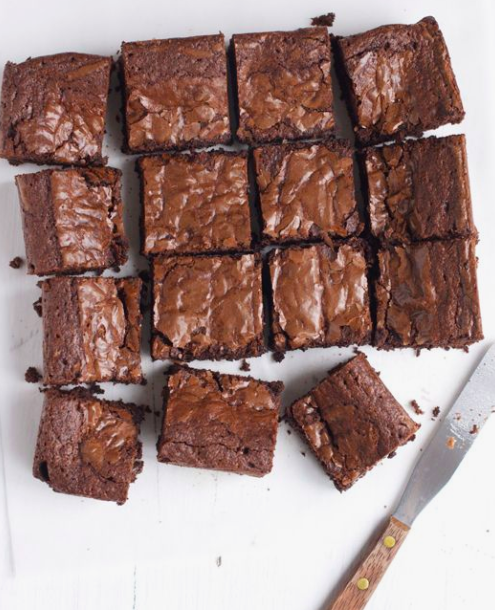
The sweetest part of your business canvas.
We have officially arrived the fun part. Figuring out how much money you’re going to be raking in! It’s taken some thought and a little bit of research to get this far so I want to congratulate you. You have already displayed more initiative than most people that daydream of starting a business.
To make an estimated guess at your expected revenue, the first thing you’ll need to do is figure out what folks are willing to pay for your food. You can do this easy enough through some Google searches. If you see wood fire pizza joint charging $20 for a large two topping pizza then assume you can get the same for now.
Using myself again as an example, I can safely project being able to sell a bag of gourmet popcorn at $10 per bag (large size).
Point of Clarification: Don’t compare yourself to big chains like a Dominos pizza or McDonald’s when establishing a retail price per unit, however. You won’t be able to get the same price ingredients that the big boys can due to their scale. Only compare your product to other ma-and-pa run restaurants to establish a more accurate price target.
Through my small amount of due diligence I’ve learned that a bag of popcorn will cost $3.00 to produce. I can then turn around and sell that same bag of popcorn for $10.00.
Next, brush up on the elementary-level math to figure out what I can expect to gross:
- 10 bags X $10.00 = $100.00
- 20 bags X $10.00 = $200.00
- 50 bags X $10.00 = $500.00
- 100 bags X $10.00 = $1000.00
- 200 bags X $10.00 = $2000.00
Going through this exercise is important from a business perspective. You want to understand what level of sales will be “worth it” to you to start the business. This is a personal question that will be different for everyone.
What’s my goal? So glad you asked! My goal is to sell 50 bags / $500 in sales per day minimum.
I use this 50 unit per day threshold to determine whether or not attending an event is worth the time and effort. I don’t always guess right and there are all sorts of factors that go into whether or not an event will be well attended (like the weather!).
That’s my minimum sales goal right now, but in the future I would love to bump up my goal to 100 sales per day. I think it’s a doable goal after testing more vending locations and events. Like everything else, it’s a process.
Net Revenue Considerations
Keep in mind that $150 of my $500 goal revenue will go straight toward paying for product expenses (popcorn, seasoning, bags). I haven’t input the cost of hiring any help for the day at $15 – $20 an hour. I haven’t factored business overhead like gas or insurance. This is all pre-tax too.
Bottom line… By the time all the expenses are taken out it’s likely the $500 gross revenue turns into $150 – $200 in your pocket for a day of work.
This may seem like a lot or not much at all depending on what you’re currently making.
Summing it all up
Don’t jump into a business without running the numbers first. If you don’t run the numbers, you might end up with a business that isn’t making the type of revenue you really want. You might also discover that the cost of getting started is more than you’d like to risk on a small business.
The goal of the entire business preparation process is to get clarity on what it’s going to take to run a business, what the costs are, and what sort of opportunity you’re looking at.
In addition to putting together this plan, I recommend watching a similar food business to the one you would like to start in action. If you want to know what it’s like running a food truck, go observe a food truck event for a couple hours. You’ll get a clear picture of what it’s really like to operate and it will cost you less than $20, including a meal and drink.
Better yet, get a part-time job working inside the type of restaurant you want to start. I’d bet you’ll find out in less than two weeks whether or not you want to operate this type of business. As an added bonus, you’ll make a couple bucks while you learn.
Finally, keep in mind that the mission statement for the business model canvas is sort of like a first draft. Don’t spend hours trying to get your adjectives perfect. Focus this time on establishing what the core company will to stand for instead of writing a flowery description.
Don’t forget to enjoy the process! Have some fun with it will ya! We’re building an awesome business here.
After you’ve created a winning business canvas, don’t stop there! The next step is to start developing a formal business plan where you’ll dive into the details of the business operations.


